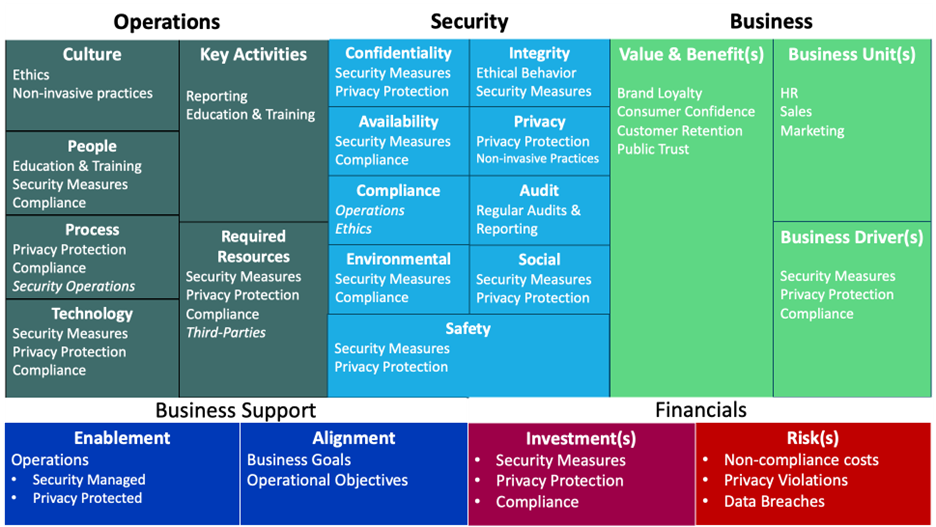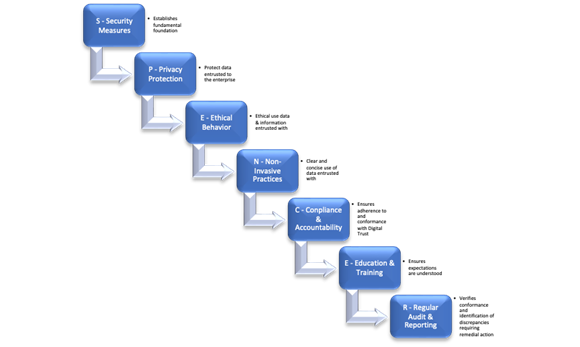In the ever-evolving digital landscape, the need for a robust framework that ensures digital trust and cybersecurity has become paramount. The SPENCER Framework is here to meet this demand and is set to revolutionize the way we approach the security and trustworthiness of our digital systems. In this blog post we’ll introduce you to the SPENCER Framework, its core components, and how it can shape a more secure digital future.
What is the SPENCER Framework?
Originally, the concept for what is now the SPENCER Framework started out due to practical necessity in order to ensure small-businesses could balance performance and conformance in a manner which considered both business needs with Information Technology, while at the same time attempting to identify the various risks to enterprise security. As illustrated below, this canvas model would be used to allow the rapid identification of impacts, based on various elements of an organization.

The SPENCER Framework has since been further developed to act as a starting point for maintaining Digital Trust – which requires a collaboration between Business and Information Technology. The initial framework started off as a modeling canvas and has since turned into comprehensive and adaptive approach to digital trust and cybersecurity. It’s designed to address the multifaceted challenges that modern organizations and individuals face in safeguarding their digital assets and maintaining trust in the digital realm. The name “SPENCER” stands for Security, Privacy, Ethics, Non-Invasiveness, Compliance, Education and Reporting, which are the core pillars of this innovative framework.
The Core Components of the SPENCER Framework
Designed initially with privacy, information and cybersecurity in mind and the need to align with business, the canvas model balanced needs of the business with Information Technology capabilities.
The canvas has since morphed into a framework built out of necessity to support our clients practically.
Security Measures – At the heart of the SPENCER Framework is the commitment to robust security measures. This component encompasses the technical safeguards, risk assessments, and threat mitigation strategies that protect your digital assets from cyber threats.
Privacy Protection – Privacy is a fundamental right in the digital age. SPENCER ensures that data protection, user consent, and transparency are at the forefront of all digital interactions.
Ethical Behavior – SPENCER strives to ensure the highest ethical standards in the digital realm are identified, maintained and aligned. It encourages organizations and individuals to embrace ethical behavior in their digital practices, ensuring fairness and accountability.
Non-Invasive Practices – Intrusive and invasive practices erode trust. The SPENCER Framework promotes non-invasive methods, prioritizing user-friendly experiences without compromising security.
Compliance & Accountability – SPENCER emphasizes the importance of compliance with regulations and accountability for data handling. This component ensures that organizations adhere to the highest standards of legal and ethical conduct.
Education & Training – Education is key to strengthening the digital defense. The SPENCER Framework encourages ongoing education and training to ensure that individuals and organizations are equipped to face evolving threats.
Regular Auditing & Reporting – Regular audits and reporting are the foundation of transparency and accountability. This component ensures that all stakeholders have a clear view of an organization’s digital trust posture.
Why SPENCER Matters
The digital landscape is rife with cyber threats, data breaches, and privacy concerns. Every individual and organization must actively participate in maintaining digital trust. The SPENCER Framework offers a holistic approach that empowers you to do just that.

In adopting the SPENCER Framework, you can:
- Strengthen your organization’s cybersecurity posture.
- Build and maintain trust with your customers and partners.
- Ensure ethical behavior in digital interactions.
- Embrace non-invasive practices that prioritize user comfort.
- Stay compliant with evolving data protection regulations.
- Invest in education and training to keep your digital workforce well-prepared.
- Demonstrate transparency through regular audits and reporting.
Conclusion
The SPENCER Framework represents a transformative approach to digital trust and cybersecurity. It’s a call to action for organizations and individuals to prioritize security, privacy, ethics, non-invasiveness, compliance, education, and transparency in their digital practices.
By adopting and integrating these core components into your digital strategy, you’ll be better equipped to navigate the challenges of the digital age, protect your assets, and maintain the trust of those you interact with. The SPENCER Framework is not just a framework; it’s a commitment to a safer, more secure digital future for all. Stay tuned for more in-depth explorations of each SPENCER component in future blog posts. Together, we can shape a digital world we can trust.
Use this framework guide to transform your Digital Trust
SPENCER Framework